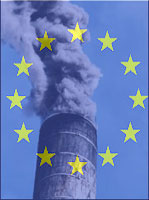
Canada & Kyoto
The Kyoto Protocol The Kyoto Protocol, negotiated in Japan's ancient capital of Kyoto in 1997 and ratified by 140 nations, is an agreement that requires 35 industrialized countries to rein in the release of carbon dioxide and five other gases from the burning of oil and coal and other processes. The Kyoto Protocol, negotiated in Japan's ancient capital of Kyoto in 1997 and ratified by 140 nations, is an agreement that requires 35 industrialized countries to rein in the release of carbon dioxide and five other gases from the burning of oil and coal and other processes.The Kyoto Protocol's entry into force means that from 16 February 2005:
View UNFCC Glossary of climate change acronyms Kyoto Protocol ArchivesMany Nations Far From Meeting Kyoto Goals When the UN's Kyoto Protocol on curbing global warming entered into force on February 16, 2005, many nations were far from meeting targets for 2012 set under the plan.
When the UN's Kyoto Protocol on curbing global warming entered into force on February 16, 2005, many nations were far from meeting targets for 2012 set under the plan.Under Kyoto, developed countries must cut emissions of carbon dioxide by an average 5.2 percent below 1990 levels by 2008-12. The United States, the world's top polluter, and Australia have pulled out of the Kyoto Protocol. The following is a list of countries that originally agreed to Kyoto targets, starting with those who have the furthest to go to even reach their 1990 baseline carbon dioxide emissions. Emissions of Green House Gases Including Emissions/Removals from Land use, Land-use Change and Forestry.
View UNFCCC GHG data webpage  Download UNFCCC GHG inventory from 1990-2007 (PDF) Download UNFCCC GHG inventory from 1990-2007 (PDF)View 2005 PlanetArk Greenhouse Emissions chart Source: UNFCCC GHG Inventory 1990-2007
Sierra Club Celebrates Kyoto Birthday Sierra Club of Canada (SCC) marked the Kyoto Protocol's one year anniversary with the release of its third annual Kyoto Report Card reviewing the different steps taken by the Canadian government to meet our targets under the protocol.
Sierra Club of Canada (SCC) marked the Kyoto Protocol's one year anniversary with the release of its third annual Kyoto Report Card reviewing the different steps taken by the Canadian government to meet our targets under the protocol.The SCC Kyoto Report Card highlights important accomplishments of the past year including idecisions to move forward with the next commitment phase under Kyoto at the December 2005 Montreal International Climate Conference and Canada's steps to regulate greenhouse gas (GHG) emissions under the Canadian Environmental Protection Act (CEPA). View February 16, 2006 Sierra Club of Canada press release  Download Sierra Club of Canada 2006 Kyoto Report Card (PDF) Download Sierra Club of Canada 2006 Kyoto Report Card (PDF)
A Brief History of UNFCCC and Kyoto Protocol The international political response to climate change began with the adoption of the United Nations Framework Convention on Climate Change (UNFCCC) in 1992. The UNFCCC sets out a framework for action aimed at stabilizing atmospheric concentrations of greenhouse gases (GHG) in order to avoid "dangerous anthropogenic interference" with the climate system. GHG covered by the framework include methane, nitrous oxide and, in particular, carbon dioxide. The UNFCCC entered into force on 21 March 1994, and now has 189 Parties. The Parties to the UNFCCC typically convene once a year in a Conference of the Parties (COP), and twice a year in meetings of the UNFCCC's subsidiary bodies.
The international political response to climate change began with the adoption of the United Nations Framework Convention on Climate Change (UNFCCC) in 1992. The UNFCCC sets out a framework for action aimed at stabilizing atmospheric concentrations of greenhouse gases (GHG) in order to avoid "dangerous anthropogenic interference" with the climate system. GHG covered by the framework include methane, nitrous oxide and, in particular, carbon dioxide. The UNFCCC entered into force on 21 March 1994, and now has 189 Parties. The Parties to the UNFCCC typically convene once a year in a Conference of the Parties (COP), and twice a year in meetings of the UNFCCC's subsidiary bodies.The Kyoto Protocol: In December 1997, delegates met at COP-3 in Kyoto, Japan, and agreed to a Protocol to the UNFCCC that commits developed countries and countries making the transition to a market economy (EITs) to achieve specific emissions reduction targets. These countries, known under the UNFCCC as Annex I Parties, agreed to reduce their overall emissions of six greenhouse gases by an average of 5.2% below 1990 levels between 2008 and 2012 (the first commitment period), with specific targets varying from country to country. The Protocol also establishes three flexible mechanisms to assist Annex I Parties in meeting their national targets cost-effectively: an emissions trading system; joint implementation (JI) of emissions-reduction projects between Annex I Parties; and the Clean Development Mechanism (CDM), which allows for projects to be implemented in non-Annex I Parties. Following COP-3, Parties initiated negotiations on most of the rules and operational details determining how countries will reduce emissions, and measure and assess emissions reductions. The Buenos Aires Plan of Action: The Buenos Aires Plan of Action (BAPA) was negotiated at COP-4 in 1998, in order to set out a process for taking forward the provisions of the Protocol. The BAPA set COP-6 as the deadline for reaching agreement on the operational details of the Protocol and on strengthening implementation of the UNFCCC. In particular, Protocol issues to be addressed included rules relating to the flexible mechanisms, a regime for assessing Parties' compliance, accounting methods for national emissions and emissions reductions, and rules on crediting countries for carbon sinks.  Following agreement on the BAPA at COP-4, subsequent meetings attempted to reach agreement on the various elements of the work programme. In November 2000, Parties met at COP-6 in The Hague, the Netherlands, and attempted to complete these negotiations without success. COP-6 was suspended until July 2001 when it reconvened in Bonn, Germany. Delegates finally agreed to adopt a political decision, the Bonn Agreements. However, this political decision needed to be operationalized through COP decisions. These decisions were considered a "package," but since agreement had not been reached on the flexible mechanisms, compliance and land use, land-use change and forestry (LULUCF), all draft decisions were forwarded to COP-7.
Following agreement on the BAPA at COP-4, subsequent meetings attempted to reach agreement on the various elements of the work programme. In November 2000, Parties met at COP-6 in The Hague, the Netherlands, and attempted to complete these negotiations without success. COP-6 was suspended until July 2001 when it reconvened in Bonn, Germany. Delegates finally agreed to adopt a political decision, the Bonn Agreements. However, this political decision needed to be operationalized through COP decisions. These decisions were considered a "package," but since agreement had not been reached on the flexible mechanisms, compliance and land use, land-use change and forestry (LULUCF), all draft decisions were forwarded to COP-7.The Marrakesh Accords: Delegates continued discussions on the Bonn Agreements at COP-7 in October/November 2001. Following extensive negotiations, the Marrakesh Accords were adopted and have served as the basis for subsequent negotiations. The Marrakesh Accords set out building blocks for decisions under the Protocol and UNFCCC, including:
 Move Toward Implementation: Delegates met at COP-8 in October/November 2002, and again at COP-9 in December 2003 to negotiate decisions for implementing the Marrakesh Accords. Among other things, Parties agreed on methods and procedures for afforestation and reforestation (A&R) activities under the CDM, including small-scale activities for the first commitment period. Parties also discussed how to incorporate findings of the IPCC's Third Assessment Report into the work of the UNFCCC.
Move Toward Implementation: Delegates met at COP-8 in October/November 2002, and again at COP-9 in December 2003 to negotiate decisions for implementing the Marrakesh Accords. Among other things, Parties agreed on methods and procedures for afforestation and reforestation (A&R) activities under the CDM, including small-scale activities for the first commitment period. Parties also discussed how to incorporate findings of the IPCC's Third Assessment Report into the work of the UNFCCC. COP-10 Report: On Monday, 6 December 2004, COP-9 Ginés González García, Argentine Minister of Health and the Environment emphasized that COP-10 was the final session prior to the Kyoto Protocol's entry into force and the first session of a new chapter devoted to taking action. He stated that advanced research and knowledge must be accompanied by increased resources, and that commitments from all members of society are needed. Kyoto Entry Into Force: February 16, 2005 Russia's formal ratification of the Kyoto Protocol on Friday, October 22, 2004 was the event that enabled Kyoto to become internationally binding for those industrialized countries that have ratified it (including Canada). It marked the crossing of the 55 country - 55% threshold; the Protocol was designed to enter into force only when ratified by at least 55 countries accounting for at least 55 percent of developed country emissions in 1990. As of February 2005, 141 Parties had ratified the Protocol, including 37 Annex I Parties. UNFCCC COP 11 & Kyoto COP/MOP 1: Hosted by Canada, Montreal, November 2005: Canada hosted the Eleventh Conference of the Parties (COP-11) to the United Nations Framework Convention on Climate Change and the First Meeting of the Parties to the Kyoto Protocol in Montreal, November 28 - December 9, 2005. The Montreal Conference on Climate (COP-11) marked the beginning of discussion among countries to determine the longer term global approach on climate change after 2012. View Manitoba Wildlands' Kyoto COP 11 MOP 1 page  Visit Climate Action Network Canada to find out the achievements in Montreal UNFCCC Subsidiary Bodies meetings, Bonn, Germany, May 2006: The twenty-fourth sessions of the Subsidiary Body for Scientific and Technological Advice (SBSTA) and the Subsidiary Body for Implementation (SBI) of the United Nations Framework Convention on Climate Change was held from 18-26 May 2006. The first session of the Ad Hoc Working Group on Further Commitments for Annex I Parties under the Kyoto Protocol (AWG) occurred 17-25 May. These sessions were preceded by the Dialogue on long-term cooperative action to address climate change by enhancing implementation of the Convention, which took place 15-16 May 2006. The Bonn meetings resulted in agreement on an ambitious agenda for negotiations of the second phase of the Kyoto Protocol over the next few years, which includes the adoption of new emissions-reduction targets for industrialized countries. UNFCCC COP 12 & Kyoto COP/MOP 2, Kenya, November 2006: Kenya hosted the second meeting of the Parties to the Kyoto Protocol (COP/MOP 2), in conjunction with the twelfth session of the Conference of the Parties to the Climate Change Convention (COP 12), in Nairobi November 6-17 2006. COP/MOP 2 carried out the first review of the Protocol under Article 9, and held discussions on a proposal by the Russian Federation on procedures to approve voluntary commitments for developing countries. UNFCCC COP 13 & Kyoto COP/MOP 3, December 3-15 2007 in Bali, Indonesia, alongside the resumed fourth session of the AWG. The main focus of the Bali conference was on long-term cooperation, and negotiators spent much of their time seeking to agree on a two-year process, or "Bali roadmap," to finalize a post-2012 regime by COP 15 in December 2009. Under the Convention, negotiations on the follow up to the Convention Dialogue resulted in the establishment of the AWGLCA with a view to launching a comprehensive process on long-term cooperative action to be completed in 2009. COP 13 identified four areas for enhanced action to be addressed by the AWGLCA, namely mitigation, adaptation, finance and technology. Its decision also contains a non-exhaustive list of issues to be considered under each of these areas and calls for addressing a shared vision for long-term cooperative action. View Manitoba Wildlands' Kyoto COP 13 MOP 3 section Visit the IISD climate change website Sources: IISD Earth Negotiations Bulletin, UNFCCC |
 2002-2014
2002-2014

